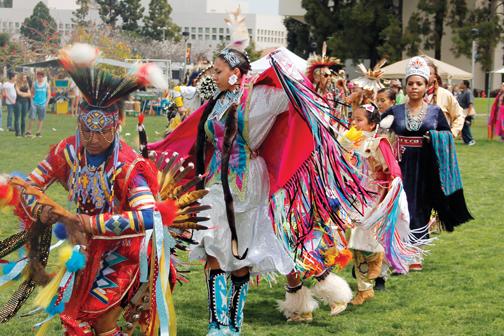
On the final weekend of spring break, a sizable crowd overtook San Diego State’s Exercise and Nutritional Sciences 700, the field south of the music building, transforming it into something far from the ordinary: a Native American powwow. Put on by SDSU’s Native American Student Alliance, the 42nd annual Iipay Tipay Mateyum Powwow and Bird Singing Gathering displayed rich tradition and a cultural diversity within the Native American tribes that came from far and wide to attend the event.
The traditional powwow usually consists of music and dancing, each steeped in tradition and characterized by elaborate regalia—outfits so detailed, they tell stories on their own. Music comes from a pounding, singing drum circle that plays for hours on end. Because of the intricacy of both the dancing and the outfits worn by the dancers, only a handful of crowd members actually participate.
“It’s always a renewal of the tribes—when they all get together you have people from all over the United States, tribal people and dances,” American Indian studies professor Richard Carrico said. “So for me, as a professor, it’s one thing to teach it, it’s another thing to live it.”

The two-day event featured a conventional powwow on Saturday, complete with traditional dances; stands selling homemade jewelry, crafts and artwork; and fry bread—a Native American dish created to efficiently stretch the rations given to reservations by the U.S. government.
Powwows are open to anyone interested in learning Native American culture. While the atmosphere was relaxed and social, the benefit of having this year’s powwow in a place as visible and accessible as SDSU’s ENS 700 allowed NASA to attract a crowd that may have been previously unaware of traditional Native American culture and customs.
Carrico said raising cultural awareness is a key part of powwows, especially in a place such as SDSU. Carrico said that compared to 30 years ago, while the average San Diegan is more aware of the city’s Native American population of approximately 40,000, people still tend to relate Native Americans with casinos. These powwows allow for exposure for some of the more personal and traditional aspects of Native American life.
“It’s one thing for Native Americans to show that they’re still here—that they’re not just here as casinos,” Carrico said.
SDSU social work senior Alicia Magallanes and her husband, an SDSU alumnus, Zeek, attend several powwows each year to experience the rich traditions found in the dancing and regalia. Magallanes volunteered this weekend to assist with the event’s setup, an opportunity she received through an American Indian studies course at SDSU.

“I really enjoy seeing all the different cultural groups come out,” Zeek said. “I studied anthropology here at SDSU, so it’s really important to me to see diversity, and to see that they want to expose the larger population to that. So I think there’s just a lack of awareness of the Native American cultural situation and history—at least see something of it.”
As for those who enjoy the social aspect of powwows, Shiigo Yellowhorse, who traveled from Los Angeles for the gathering, has been dancing at powwows since he could walk. At 18 years old, Yellowhorse is this year’s head man—an esteemed position at the powwow. He practices the symbolic men’s chicken dance at powwows.
“There’s a lot of versions behind it, but the story I’m told is that it’s a mating dance,” Yellowhorse said. “When you’re dancing, you’re supposed to attract the hen. So, you’re out in the prairie field, showing off your moves and stuff, trying to attract the hen.”
Former American Indian studies professor Roy Cook saw this powwow develop from humble beginnings. As an undergraduate at SDSU in 1970, he saw an advertisement in The Daily Aztec asking students interested in Native American culture to meet at Montezuma Hall. He began playing a role in organizing the powwows around the time of his graduation in 1971 and after witnessing the powwow take place at several different locations around campus, including Montezuma Hall, Aztec Center and the Parma Payne Goodall Alumni Center. After spending time away from San Diego working in the private sector, he returned to teach American Indian studies at SDSU for a decade.

Now retired, Cook plays an active role as the historian for the American Indian Warriors Association, a group of Native Americans veterans who, in Cook’s words, have “demonstrated a commitment to defending this land.”
On Saturday, he was one of the few veterans who had the honor of carrying one of the flags during the Grand Entrance, the ceremony in which key participants of the powwow present themselves to the crowd. Because he is one of the most familiar with the Iipay Tipay Monteyum Powwow, he’s seen it evolve and change throughout the past four decades.
“They’re like an accordion—sometimes they’re bigger, sometimes they’re smaller,” Cook said.
Powwows are generally open to anyone who’s interested in experiencing or furthering their knowledge about Native American culture. Upcoming powwows and other events can be found on the websites of NASA and the SDSU Department of American Indian Studies.







